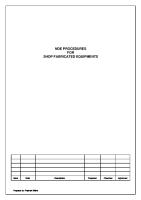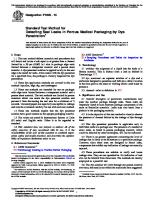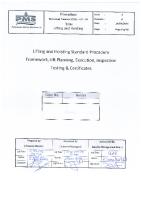Dye Penetrant Procedure [PDF]
DYE PENETRANT TESTING PROCEDURE TUNISIA - SFAX: Road Mahdia Km 1, N°84 Street Mohamed Ikbal, P.O. Box: 89A 3099 Sfax Tu
46 1 625KB
Papiere empfehlen
![Dye Penetrant Procedure [PDF]](https://vdoc.tips/img/200x200/dye-penetrant-procedure.jpg)
- Author / Uploaded
- Touil Houssem
Datei wird geladen, bitte warten...
Zitiervorschau
DYE PENETRANT TESTING PROCEDURE
TUNISIA - SFAX: Road Mahdia Km 1, N°84 Street Mohamed Ikbal, P.O. Box: 89A 3099 Sfax Tunisia, Tel: +216 74232032 / Fax: +216 74234717.
- TUNIS: 13 Street Michael Noaima 2080 Arian Tunisia, Tel: +216 71 820205, Fax: 71 820128. - GABES: Street Environment Chenini Nahal 6041,Tel / Fax: +216 75229440. LIBYA: BECA Libya For Inspection, Testing And Analysis, Street 16 off 11 June Road Nearby Ben Zahra Mosque Souk Al Joumaa Tripoli Libya,Tel / Fax: +218 (0) 213501973.
ABU DHABI: BECA Abu Dhabi, Branch UAE, P.O. Box: 129865 Abu Dhabi UAE, Tel: +971(0) 25102400, Fax: +971 (0) 25589961.
TECHNICAL DEPARTEMENT
GABON: BECA Securale De Gabon, Boulevard Léon MBA Quartier Littoral face central SEEG B.P. N°1701
BECA COMPANY
Port – Gentil Gabon, Tel / Fax: +241 01569527. CONGO : Luanda Pointe Noire – Congo Tel : +242069069213 Email:[email protected]
DYE PENETRANT TESTING PROCEDURE
T.P – N.D.T 004
This document is the property of BECA; no part of it shall be reproduced or transmitted without prior written BECA’s authorization.
T.P – N.D.T – 004
Page 2 of 8
Revision 7
DYE PENETRANT TESTING PROCEDURE
T.P – N.D.T 004
SOMMAIRE
1 2 3 4 5 6 7 8 9 10 11
Object : ........................................................................................................................................ 4 Reference documents ................................................................................................................ 4 Qualification of personnel ......................................................................................................... 4 Operating Conditions ................................................................................................................. 4 Visual inspection ......................................................................................................................... 4 Equipments ................................................................................................................................. 5 Procedure ................................................................................................................................... 5 Interpretation of indications ..................................................................................................... 6 Acceptance standard ................................................................................................................. 6 Cleaning :......................................................................................................................................7 Report ..........................................................................................................................................7
This document is the property of BECA; no part of it shall be reproduced or transmitted without prior written BECA’s authorization.
T.P – N.D.T – 004
Page 3 of 8
Revision 7
DYE PENETRANT TESTING PROCEDURE
T.P – N.D.T 004
1. Object : This procedure describes the equipment, method, acceptance criteria, personnel qualifications and all the details necessary to perform a penetrant examination of butt welds and fillet welds. 2. Reference documents The standards listed in this paragraph are always applicable in their latest revised version. ASME Code Section VIII. ASME Code Section V. API 650. 3. Qualification of personnel 3.1. Qualification procedure
COTEND or ASNT certified personnel.
3.2. Level of Certification The examination is performed by an operator Level I, interpretation is performed by a Level II certified Inspector. 4. Operating Conditions 4-1.Examination areas This procedure applies to butt welded joints and fillet welds in carbon steel, alloy steel and stainless steel. The entire weld and heat affected area within 1" shall be inspected. 4-2. Temperatures The parts to be tested must have a temperature between 10 ° C and 50 ° C. 4-3.Preparation of surfaces Surfaces must be free from paint, scale, grease and any other material that may interfere with penetrant testing. Cleaning can be done by degreasing, pickling or brushing. Mechanical methods, such as grinding and light sandblasting must be used with care to avoid blocking surface discontinuities. Shot blasting is not recommended. The roughness must be less than or equal to 6.3 um for the machined surfaces and to 12um for the raw parts. 5. Visual inspection The weld area will be visually inspected so as not to interfere with the interpretation after
This document is the property of BECA; no part of it shall be reproduced or transmitted without prior written BECA’s authorization.
T.P – N.D.T – 004
Page 4 of 8
Revision 7
DYE PENETRANT TESTING PROCEDURE
T.P – N.D.T 004
examination. The Finishing pass should be uniform and the allowance should not exceed the values specified by the reference code. 6. Equipments 6.1. Penetrant testing Products All products used: degreaser, penetrant, penetrant and developer remover, must be compatible with the controlled material. 6.1.1. Cleaners Non-exhaustive list of usable products: Water Acid, alkaline stripping, rinsing follow-up Degreaser, solvent, etc. 6.1.2. Penetrating The usable penetrant is: Pre-emulsified colored penetrant in liquid suspension washable with water or with a suitable solvent. 6.1.3. Developer There are three types of developer: Non aqueous wet developer. Aqueous wet developer. Dry developer. 6.2. Lighting The use of a colored penetrant requires natural or artificial lighting of 1000 Lux value. These values are appreciated on the surface of the part to be checked, measurements are made with the Lux meter. 7. Procedure 7.1 Application of Penetrant Product The application of penetrant product can be with a spray gun, an aerosol can, a brush or by immersion. The impregnation time must not be less than that indicated by the manufacturer (Generally
This document is the property of BECA; no part of it shall be reproduced or transmitted without prior written BECA’s authorization.
T.P – N.D.T – 004
Page 5 of 8
Revision 7
DYE PENETRANT TESTING PROCEDURE
T.P – N.D.T 004
between 10 and 30 minutes). The layer of penetrating material must remain moist throughout the impregnation period. 7.1.1 Elimination of excess penetrant: Excess penetration in the surface will be reduced by using a lint-free cloth, a brush, a jet of water under pressure of less than 3 bars, by immersion, by paper towel or solvent. 7.1.2 Drying: Once the cleaning is completed, the surface to be checked is dried either in the open air, using a dry, lint-free cloth, absorbent paper or under compressed air with a pressure of less than 2 bars and under a temperature not exceeding 40 ° C. 7.2 Application of developer After drying is completed, the developer will be applied to the area to be checked into a thin, uniform layer. The liquid developer should be agitated to mix the suspended particles (using aerosol cans or a suitable spray gun without air emulsion) If the ambient temperature is between 5 ° C and 10 ° C, the developer is applied by means of an aerosol can. In addition, drying must be accelerated by blowing air if possible; its temperature at the surface of the test coupon must not exceed 40 ° C. The indications are evaluated at the earliest 10 minutes and at the latest 30 minutes after the developer have dried. However, a longer time may be required for some additional investigations. 8. Interpretation of indications Interpretation in daylight or artificial (1000 lux minimum) must be performed between 10 minutes and 30 minutes after the developer has dried. 9. Acceptance standard The acceptance criteria are designated according to the acceptance limits given in ASME code VIII and the technical specifications of the customer. The indications are defined according to ASME VIII as follows: A linear indication is an indication that has an indication length greater than three times its width. A circular or elliptical indication is an indication that has the length of the indication less than or equal to three times its width. This document is the property of BECA; no part of it shall be reproduced or transmitted without prior written BECA’s authorization.
T.P – N.D.T – 004
Page 6 of 8
Revision 7
DYE PENETRANT TESTING PROCEDURE
T.P – N.D.T 004
Acceptance Criteria according to the ASME Code Section VIII: All surfaces tested should be free of: All linear indications. All circular indications having dimensions greater than 3/16 "(5 mm). Four or more circular indications on a line separated by a distance of 1/16 "(1.5 mm) or less. 10. Cleaning : Cleaning after examination is carried out after checking. This cleaning can be carried out with cleaning solvent and rags or with brushing. 11. Report After each penetrant inspection, the Level II inspector must prepare an inspection report and forward it to the customer
This document is the property of BECA; no part of it shall be reproduced or transmitted without prior written BECA’s authorization.
T.P – N.D.T – 004
Page 7 of 8
Revision 7
DYE PENETRANT TESTING PROCEDURE
T.P – N.D.T 004
This document is the property of BECA; no part of it shall be reproduced or transmitted without prior written BECA’s authorization.
T.P – N.D.T – 004
Page 8 of 8
Revision 7





![Dye lasers [Enlarged 3rd]
9783540515586, 3540515585](https://vdoc.tips/img/200x200/dye-lasers-enlarged-3rd-9783540515586-3540515585.jpg)



